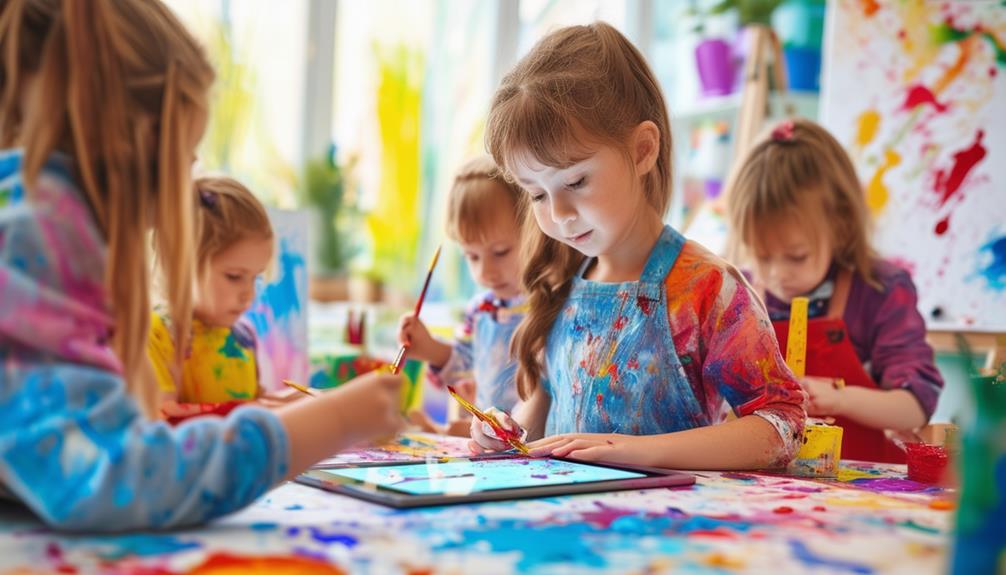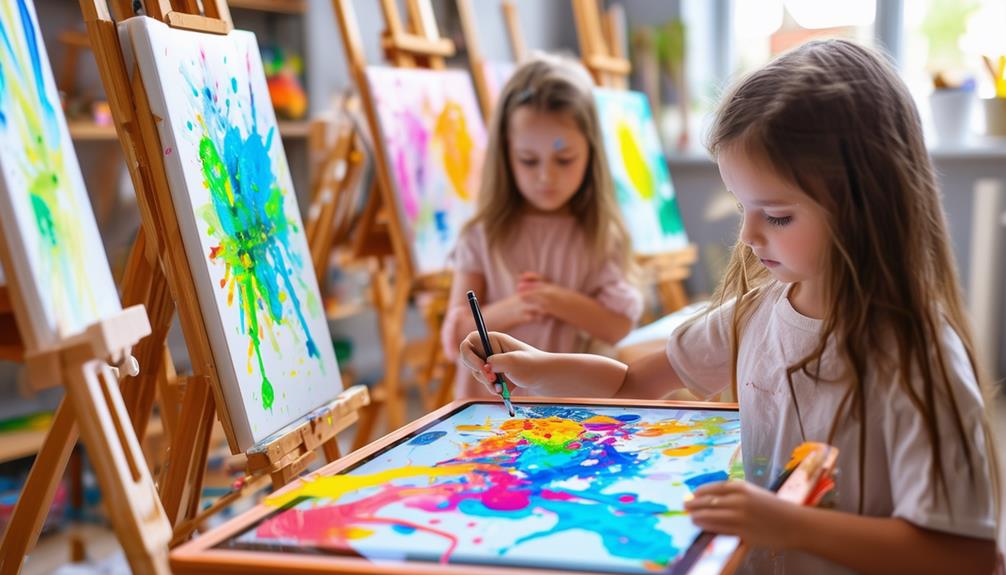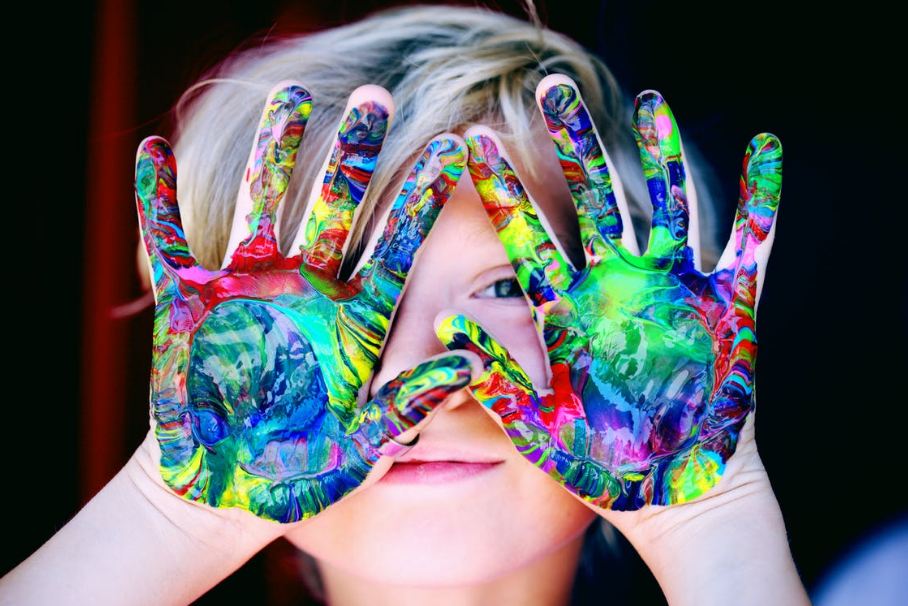How to Integrate Technology and Painting: Digital Art for Kids

Integrating technology and painting to produce digital art for kids is not just about keeping up with trends; it's about expanding their creative possibilities. For instance, you can introduce them to digital paint pouring, where they manipulate virtual paints to create unique patterns. Alternatively, explore digital watercolor and chalk backgrounds that mimic traditional methods without the mess. Animating their existing artworks can also help children see their creations come to life, enhancing their artistic skills. If you're interested in blending traditional art methods with modern technology, there is a wealth of opportunities to explore.
Digital Paint Pour Challenge
Dive into the Digital Paint Pour Challenge and explore vibrant, fluid paint effects without the mess. This creative activity allows you to use digital tools to replicate traditional paint pouring techniques like dirty pour, flip cup, and swipe methods. Experiment freely without worrying about spills or cleanup.
Control the flow and colors of your digital paint with precision. Choose every detail, from the paint's viscosity to the way it spreads and blends. This level of control helps you create unique, visually appealing designs. Digital drawing tools offer customizable options to perfectly match your vision.
For kids, this challenge serves as an excellent introduction to digital art and painting techniques. It's fun, engaging, and educational, allowing them to learn about color theory and design principles in an exciting, mess-free environment. The Digital Paint Pour Challenge nurtures a love for digital drawing and opens up endless artistic possibilities.
Watercolor and Chalk Backgrounds
After mastering the Digital Paint Pour Challenge, kids can further enhance their artistic skills by exploring digital watercolor and chalk backgrounds. These techniques can be easily achieved using a variety of software tools, offering unique textures and effects that bring digital art to life.
Digital watercolor backgrounds mimic the gentle, flowing effect of traditional watercolor painting. They can be customized with different colors and blending options to match the artist's vision. Kids will enjoy how these backgrounds add richness to their digital art projects without the mess of actual watercolors.
Chalk backgrounds, on the other hand, provide a textured, artistic look that adds depth and intrigue to any piece of art. By experimenting with various textures, colors, and blending techniques, kids can create striking chalk effects that elevate their digital artwork.
- Digital Watercolor Backgrounds: Gentle, flowing effects similar to traditional watercolor painting.
- Chalk Backgrounds: Textured appearance that adds depth and interest.
- Customization Options: Endless possibilities with colors, textures, and blending.
Using digital tools encourages limitless experimentation and creativity, empowering young artists to discover and refine their skills in digital art. Encourage them to try out different techniques and see where their creativity takes them!
Animating Existing Artworks

Animating existing artworks allows you to transform static images into dynamic pieces using simple techniques and digital tools. Software like Adobe Photoshop, Procreate, and After Effects can be utilized to add movement and effects to your paintings. This process enriches your storytelling, enhances your digital art skills, and provides an engaging, interactive experience.
Techniques for Animation Effects
Bringing static artworks to life with animation effects can captivate and inspire young artists, adding a new layer of excitement to their projects. By incorporating animation techniques, simple drawings or paintings can be transformed into dynamic pieces that tell engaging stories. Here are some techniques to digitally animate existing artworks:
- Frame-by-Frame Animation: This method involves creating individual frames for each movement. While time-consuming, it offers precise control and a classic aesthetic.
- Motion Tweens: Ideal for beginners, motion tweens allow you to define start and end points for an object, with the software automatically generating the in-between frames.
- Layer Animations: By using layers, different parts of the artwork can be animated separately, resulting in more complex and engaging animations.
Animating existing artworks not only enriches storytelling but also fuels creativity in digital art projects for kids. Young artists can experiment with various movements and effects, bringing their creations to life. Digital tools like Adobe Animate or Procreate offer features specifically designed for seamless animation, making it easier than ever to get started. So, dive into the world of animation and watch as static images burst into action!
Tools for Animation Creation
Digital tools like Adobe Animate and Toonly make it easy for kids to animate their existing artworks. These platforms offer user-friendly interfaces with drag-and-drop features, simplifying the animation creation process. Children can quickly learn to use these tools, experimenting with techniques that turn static images into dynamic stories.
Adobe Animate allows kids to add effects, changes, and sound to their artwork, enhancing the visual experience and enabling them to explore storytelling. Toonly specializes in creating fun, engaging characters and scenes, making it an ideal choice for younger kids new to animation.
Animating existing artworks helps children develop creativity and storytelling skills. They gain a better understanding of visual communication as they see how their static drawings can evolve into interactive pieces. This process encourages them to think about their art in new ways, exploring dimensions of artistic expression beyond traditional painting and drawing.
Typography Printmaking
Typography printmaking merges the art of lettering with traditional printmaking techniques to create unique designs. As an art teacher, you can introduce children to this fascinating blend, allowing them to experiment with diverse fonts and layouts. This technique not only produces beautiful prints but also teaches kids about the importance of typography in art and design.
Begin by showing students how to use carved letters or digital fonts to transfer their designs onto paper or fabric. This process can be done manually with carving tools or digitally using software like Adobe Illustrator. Here are some engaging activities you can try:
- Manual Carving: Teach children how to carve letters into linoleum or rubber blocks and make prints.
- Digital Design: Use Adobe Illustrator to create and print custom typography designs.
- Mixed Media: Combine manual and digital techniques for unique, layered prints.
Typography printmaking encourages creativity and innovation, as kids can experiment with different fonts, sizes, and layouts to achieve varied visual effects. By integrating this technique into your lessons, you'll help students appreciate the intricacies of both typography and printmaking.
Custom Stencils
Creating personalized stencils allows children to effortlessly incorporate unique, intricate details into their digital art projects. By leveraging technology, children can design customized stencils that enhance their creativity and artistic expression. These stencils enable young artists to experiment with various shapes, sizes, and patterns, resulting in visually compelling artwork.
Combining traditional art methods with modern digital tools, software can be used to design personalized stencils for both printing and digital use. This interactive approach merges conventional art techniques with contemporary resources, making it easier for children to achieve polished outcomes. For example, they can create a stencil on a tablet and then use it to apply consistent patterns or textures to their digital artwork.
Personalized stencils provide a structured way to explore creativity, allowing children to focus on the intricate aspects of their projects without feeling overwhelmed. They can experiment with different designs and see immediate results, fostering a sense of accomplishment. Moreover, using stencils teaches children about symmetry, repetition, and spatial awareness in an enjoyable manner.
Integrating personalized stencils into digital art projects is an excellent way to harness technology and enhance a child's artistic skills.
Drawing Digitally
Now that you're ready to start drawing digitally, let's discuss the essential tools, sketching techniques, and ways to incorporate multimedia into your artwork. Digital drawing platforms offer a variety of brushes, colors, and effects that enable easy and enjoyable experimentation. With just a few clicks, you can explore different styles and bring your creative ideas to life seamlessly.
Essential Digital Drawing Tools
When sketching digitally, a variety of essential tools such as brushes, pens, and layers are at your disposal to enhance your artwork. These tools optimize efficiency and precision, simplifying intricate projects. Digital drawing offers flexibility to experiment with different styles and techniques without the hassle of traditional materials.
Here are crucial digital drawing tools you should explore:
- Brushes and Pens: These replicate traditional drawing instruments, allowing you to create diverse textures and effects. From watercolor to charcoal, there is a brush for every need.
- Layers: Layers enable you to separate different elements of your artwork, giving you control and the ability to make adjustments without affecting the entire piece.
- Multimedia Integration: Incorporate photos, textures, and other multimedia elements to add depth and complexity to your creations.
Techniques for Digital Sketching
Mastering digital sketching techniques can significantly enhance your artistic skills and streamline your creative process. Digital sketching involves using tools like tablets, styluses, and software to create virtual art. You can experiment with a variety of brushes, colors, and effects without the worry of making permanent mistakes. The ability to undo errors and work in layers lets you refine your sketches to perfection.
Digital sketching offers precision and control, enabling you to create intricate designs with ease. Here's a quick overview of key benefits:
| Digital Tools | Benefits |
|---|---|
| Tablets and Styluses | Precision and Control |
| Software Effects | Experimentation |
| Layer Functionality | Refinement and Editing |
Using a tablet and stylus allows you to achieve a level of detail that's challenging to match with traditional methods. Software effects let you try different looks quickly, promoting a dynamic and fluid creative process. Layer functionality is a game-changer, enabling you to separate different parts of your sketch for adjustments without affecting the whole piece.
Sharing and saving your virtual art is also straightforward, facilitating collaboration and showcasing your work. Immerse yourself in digital sketching and watch your creativity soar!
Integrating Multimedia in Drawings
Integrating multimedia into digital drawings enhances your creations with animation, audio, and interactive elements, transforming them from static images into dynamic masterpieces. Digital drawing tools offer a wide range of options, including colors and effects, allowing you to experiment with different styles and create intricate artworks effortlessly.
Adding multimedia elements not only makes your digital drawings more engaging but also opens up opportunities for collaboration. Imagine working on a group project where each team member contributes unique elements like sound effects, animations, or interactive buttons. This collaborative approach fosters creativity and teamwork, making the artistic process more enjoyable.
Here are a few ways to integrate multimedia into your digital drawings:
- Animate your drawings: Add simple animations to make your characters move and bring your art to life.
- Incorporate audio: Embed sound effects or background music to create a more immersive experience.
- Interactive elements: Add clickable elements that can trigger animations or sounds to make your artwork interactive.
Digital drawing also enhances efficiency and precision, allowing you to refine your work with minute adjustments. By integrating multimedia, you can elevate your digital art, making it more engaging and interactive.
Exploring 3D Pens and Printing

Dive into the world of 3D pens and printing to turn your digital art into physical creations. With 3D pens, you can draw in the air using heated plastic filaments, creating three-dimensional artworks right before your eyes. This interactive tool allows you to explore spatial thinking and design principles in a fun and engaging way. By manipulating the pen, you'll understand the concepts of volume and shape, bringing your art to life in an entirely new dimension.
Additionally, 3D printing offers another exciting method for realizing your digital designs. This technology layers materials to create physical objects based on your digital blueprints. Imagine designing a character on your computer and then holding it in your hands—3D printing makes this possible! It's an incredible opportunity to delve into the world of design and engineering while enhancing your creativity and innovation.
Digital Literacy With Coding
Transitioning from 3D creations to digital coding, you'll explore how computational thinking can animate and enhance your digital art. Coding in digital art goes beyond crafting visually appealing images; it equips you with critical problem-solving skills and computational thinking. Platforms like Scratch and Tynker allow kids to dive into the coding world while designing their digital masterpieces.
Integrating coding into your digital art projects enables you to:
- Animate your artwork
- Create interactive elements
- Program visual effects
Understanding basic coding concepts lets you customize your projects in previously unimaginable ways. Whether it's animating a character to dance across the screen or adding interactive buttons that change the scene's color, coding transforms static images into dynamic creations.
Combining your painting skills with coding knowledge allows you to produce unique and dynamic digital artworks. Imagine painting a beautiful sunset and then using coding to make the sun gradually set. These skills not only enhance your art but also build a solid foundation in digital literacy. So, grab your tablet and start exploring the endless possibilities that coding brings to your digital art adventures!




